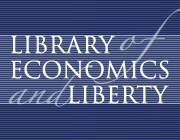
Leon Walras |

But Walras was aware that the mere fact that such a system of equations could be solved mathematically for an equilibrium did not mean that in the real world it would ever reach that equilibrium. So Walras's second major step was to simulate an artificial market process that would get the system to equilibrium. This process he called "tâtonnement" (French for groping). Tâtonnement was a trial-and-error process in which a price was called out and people in the market said how much they were willing to demand or supply at that price. If there was an excess of supply over demand, then the price would be lowered so that less would be supplied and more would be demanded. Thus would the prices "grope" toward equilibrium. To keep constant the equilibrium toward which prices were groping, Walras assumed, highly unrealistically, that no actual exchanges were made until equilibrium was reached. If, for example, people who wanted to buy ketchup wanted more than sellers were willing to sell, then they would buy none at all. This assumption limits the usefulness of Walras's simulated process as an aid to understanding how real markets work.
Walras's sole academic job was as an economics professor at the University of Lausanne in Switzerland. This location was not ideal: because the dominant thinking in economics at the time was in Britain, it was difficult for Walras to affect the rest of the profession. Also, because his students were more interested in becoming lawyers than in becoming economists, Walras did not have disciples. Although his impact on economics was limited during his lifetime, it has been much greater since the thirties. Historian of economic thought Mark Blaug writes that Walras "may now be the most widely-read nineteenth century economist after Ricardo and Marx."
Walras's father, the French economist Auguste Walras, encouraged his son to pursue economics with a particular emphasis on mathematics. After sampling several careers—he was for a while a student at the School of Mines, a journalist, a lecturer, a railway clerk, a bank director, and a published romance novelist—Walras eventually returned to the study and teaching of economics. In that scientific discipline Walras claimed to have found "pleasures and joys like those that religion provides to the faithful." Walras retired in 1902 at age fifty-eight.
Return to top